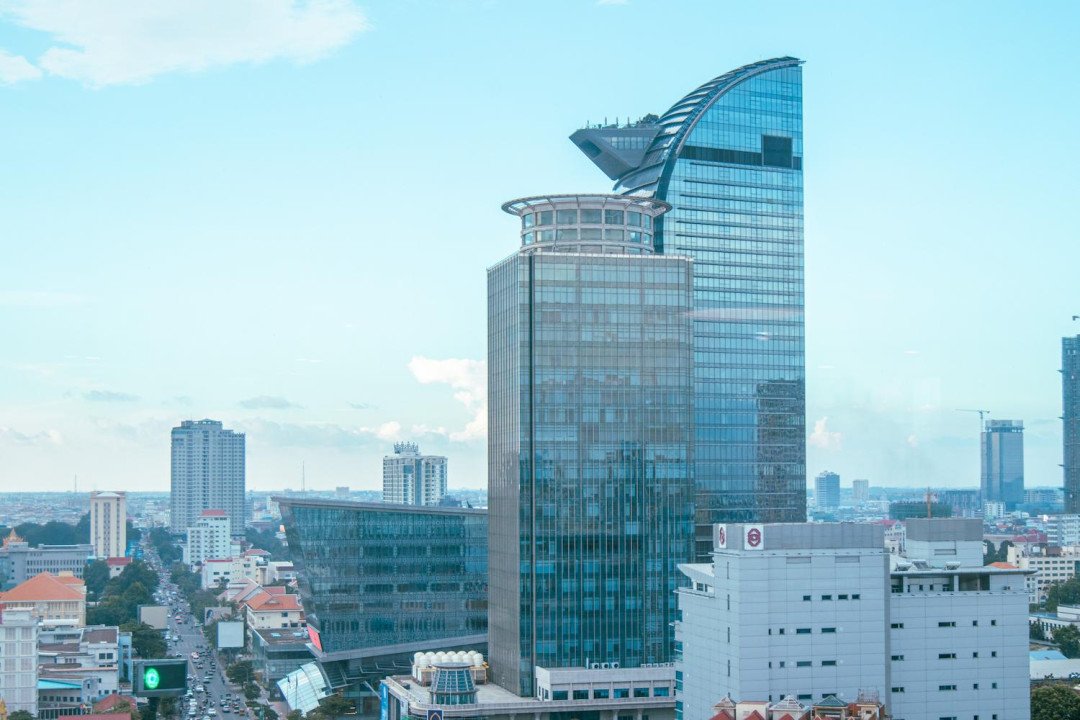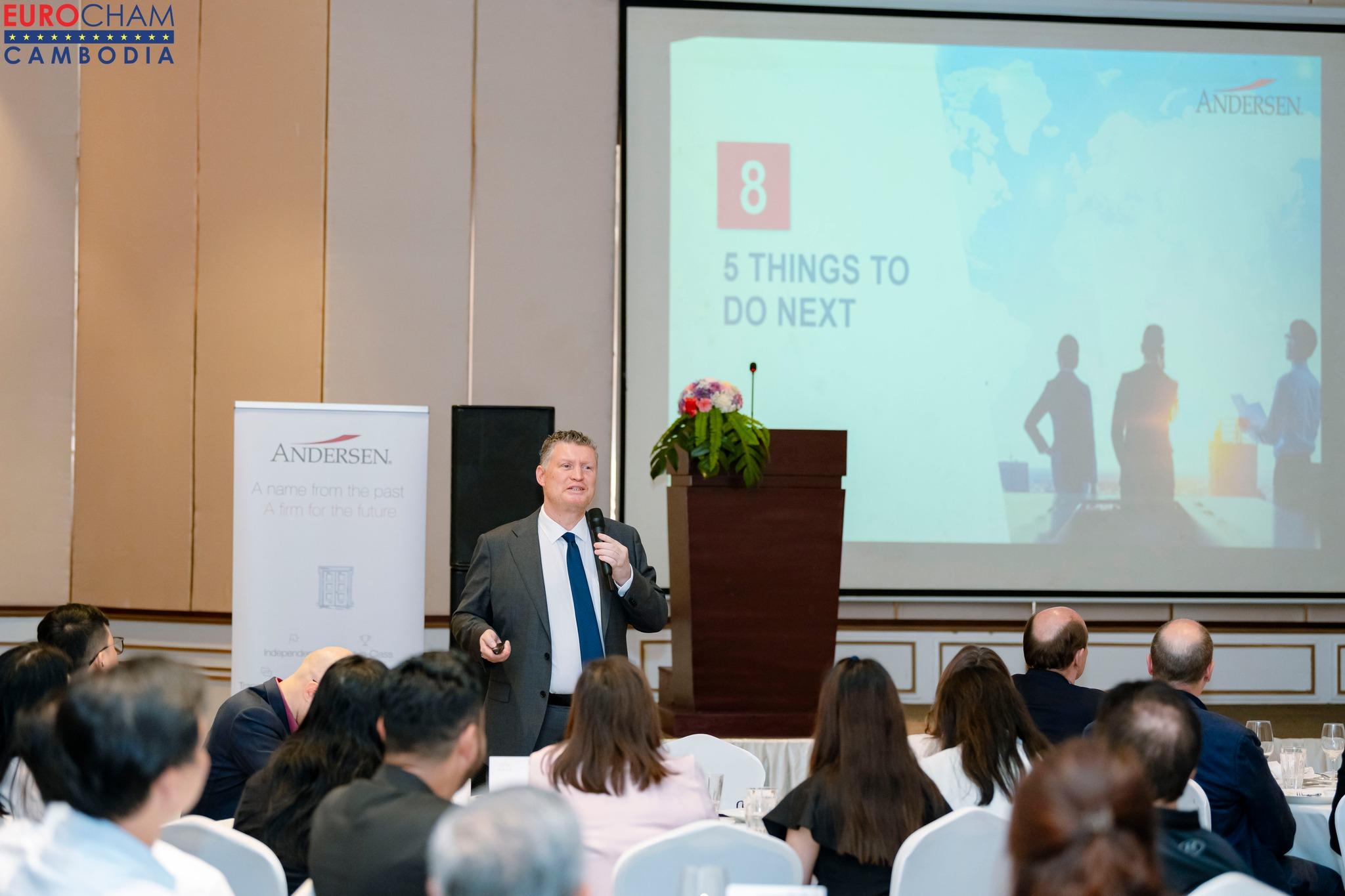Understanding U.S. Tariffs: How Should Cambodia Respond?

EuroCham Cambodia hosted a luncheon centred on ‘Global Trade Tensions: Are You Tariff Ready?’ on April 24, 2025, to explore the international trade law aspects of looming U.S. tariffs in Cambodia. Many legal professionals agree the new tariffs appear to violate international trade rules set by the World Trade Organisation (WTO), so how should the Kingdom respond?
Edwin Vanderbruggen, Senior Partner at Andersen, was the main speaker at the event, providing a practical review of what is happening in international trade law today in light of the Trump administration’s tariff disruptions. He discussed the rationale behind recent U.S. trade policies, their legal implications under WTO rules, and the potential fallout for Cambodia’s export-driven economy.
Cambodia was hit with 49 per cent ‘reciprocal’ tariffs in early April and subsequently faced over 3,500 per cent tariffs on its solar cell exports to the United States, who alleged that Cambodia and other Southeast Asian countries were benefiting from “unfair Chinese subsidies” funneled through their manufacturers.
Vanderbruggen warned that the proposed tariff on Cambodian goods to the U.S. would necessitate structural trade adjustments and greater transparency in regulatory practices from Cambodia.
What Does the U.S. Want From Cambodia?
Vanderbruggen underlined that it’s unclear what problems the U.S. is trying to solve, whether it’s reducing a trade deficit, reshoring the manufacturing industry to the U.S., raising non-income tax revenue, or if these are just irrational and disruptive motives at play.

In terms of how Cambodia should respond, he said that joining other countries to sue the U.S. for violating international trade rules might be an option, but this avenue is limited for Cambodia as the country has never filed such an international dispute or been involved in one under the WTO.
Another strategy for Cambodia could be lobbying for further delays or exceptions with the U.S., but the question then is about who would handle that. Perhaps more realistic routes are for the Kingdom to renegotiate its bilateral and multilateral deals, improve its trade compliance (for e.g. regarding intellectual property and non-tariff barriers), or renegotiate at the WTO level.
Commenting on the strategy so far shown by the U.S. government, Vanderbruggen stated that it is completely impossible for the U.S. to actually renegotiate its trade agreements with 60 countries (roughly the number of countries hit with additional tariffs) even during Trump's entire second term.
“It is completely and utterly impossible,” he started. “If you want to renegotiate with 60 countries, we have a platform for that; it's called the WTO. They are the only ones equipped for this, with experts in Geneva who actually know about these issues, and they have been renegotiating these trade agreements, including with Cambodia.”
Vanderbruggen further emphasised that there is no doubt that the U.S. tariffs are completely and entirely in violation of WTO rules. Nevertheless, he said Cambodia can take the moral high ground by reducing unnecessary non-tariff measures such as import licenses and various bureaucratic hurdles.
“We can do much better in that respect, closer to Vietnam and Singapore's approach. That is just sensible trade policy, regardless of future U.S. tariffs,” he said.
Can Cambodia Buy More U.S. Goods to Address Trade Imbalance?
Even though Cambodia is trying to double its imports from the U.S. to address the trade imbalance between the two countries, Vanderbruggen explained that the Kingdom can only realistically reduce its tariffs from 49 per cent to 47 per cent, based on the formula the U.S. used to calculate tariffs, which he emphasised is completely irrational.
He added:
If the U.S. wants Cambodians to buy more of their products, they should focus on producing better and cheaper goods than their competitors from other countries, instead of blaming everyone but themselves. If they can't, then they should concentrate on producing goods and services where they can compete and liberalise trade in other areas.
He also shared that Cambodia is currently purchasing more second-hand cars from Japan than the U.S. because cars from Japan are much cheaper and are typically of higher quality.
Practical Steps for Cambodia in Addressing Mounting Tariffs
Vanderbruggen advised Cambodia to diversify its trade partners by leveraging the Regional Comprehensive Economic Partnership (RCEP) – which includes ASEAN countries, China, Japan, South Korea, Australia, and New Zealand – and expanding trade opportunities.
He also suggested Cambodia should actively pursue free trade agreements (FTAs) with new partners, particularly recommending negotiating an FTA with the European Union (while negotiations with Vietnam and Singapore are already done and Thailand is in progress) and seeking trade agreements with Canada, Turkey, the Southern Common Market (Mercosur), and other potential markets.
Vanderbruggen noted that tourism is a key factor for growth in Cambodia, however, he believes the country is currently not utilising all of its strengths in this area as effectively as it could. To that note, he emphasised that jobs in tourism with skilled labour pay significantly better than those in manufacturing and agriculture.
On the subject of the services industry and the potential it holds to further boost Cambodia’s economy, Vanderbruggen said it ultimately comes down to skills, and Cambodia unfortunately still relies largely on unskilled labour, so the country is not able to be properly competitive within this area.
“This comes down to education, to vocational training. Schools should be teaching what provides students jobs, not following the curriculum necessary. This is one of the long-term strategic challenges… We need better skilled labour, which will be a key facet of any strategy the country takes,” he concluded.